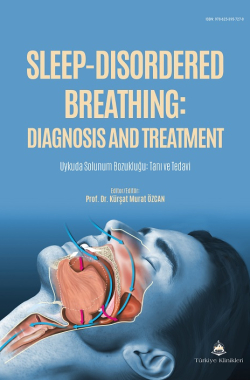THE ROLE OF NASAL SURGERY IN OBSTRUCTIVE SLEEP APNEA (OSA)
Osman Cerlet
Ankara Bilkent City Hsopital, Department of Otorhinolaryngology, Ankara, Türkiye
Cerlet O. The Role of Nasal Surgery in Obstructive Sleep Apnea (OSA). In: Özcan KM, editor. Sleep-Disordered Breathing: Diagnosis and Treatment. 1st ed. Ankara: Türkiye Klinikleri; 2025. p.139-144.
ABSTRACT
Sleep apnea, particularly the obstructive type (OSA), is a disorder that occurs due to obstructions in the upper airway and can lead to serious health problems. Anatomical factors that cause upper airway stenosis play a significant role in the pathophysiology of OSA. Identifying the contributing factors and selecting the appropriate treatment for each patient is crucial for success. Anatomical abnormalities can occur at various levels within the upper airway. The presence of a pathology causing narrowing in the oropharynx or the base of the tongue should also be evaluated by an otolaryngologist. Common pathologies that cause narrowing in the nasal cavity include septal deviation, turbinate hypertrophy, and nasal valve problems. Other less common pathologies that impair nasal airflow include choanal atresia, synechiae, benign or malignant tumors in the nose and paranasal sinuses, and nasal polyps. The nasal cavity is a significant point of resistance for airflow in the upper airway. With nasal obstruction, inspiratory effort increases and causes multiple narrowings in the lower parts of the upper airway. If a deviated septum, a common nasal pathology, causes narrowing in the nasal passages, surgery may be performed. Septoplasty relieves the stenosis caused by deviated cartilage and bone. Septoplasty can be performed in the same session as other nasal surgeries. Surgery for turbinate hypertrophy is often performed in conjunction with other nasal surgeries. The most common surgeries for turbinate hypertrophy are turbinate lateralization and radiofrequency turbinate reduction. Turbinate lateralization involves first fracturing the medially located inferior turbinates medially and then laterally retracting them. Radiofrequency, which has become increasingly common in recent years, is applied to the turbinate using electrodes without damaging the mucosa. The goal is to induce contraction and fibrosis in the submucosal tissue of the turbinate. Aggressive turbinectomy techniques that damage the mucosa are not preferred. Surgery is also indicated for patients with static and dynamic stenosis in the nasal valve region. Nasal surgery can be performed alone or as part of a multilevel procedure involving sleep surgery in other regions. Nasal surgery alone plays an important role in alleviating sleep apnea symptoms and improving treatment compliance. However, in OSA cases that result from multiple contributing factors, the benefit of nasal surgery remains limited. Nasal surgeries have been shown to increase compliance with positive airway pressure therapy and therefore remain important.
Keywords: Functional nasal surgery; Obstructive sleep apnea; Continuous positive airway pressure; Nasal septum; Turbinates
Kaynak Göster
Referanslar
- Lofaso F, Coste A, d’Ortho MP, Zerah-Lancner F, Delclaux C, Goldenberg F, et al. Nasal obstruction as a risk factor for sleep apnoea syndrome. Eur Respir J. 2000;16(4):639-43. [Crossref] [PubMed]
- Zwillich CW, Pickett C, Hanson FN, Weil JV. Disturbed sleep and prolonged apnea during nasal obstruction in normal men. Am Rev Respir Dis. 1981;124(2):158-60. [Crossref] [PubMed] [PMC]
- Inoue A, Chiba S, Matsuura K, Osafune H, Capasso R, Wada K. Nasal function and CPAP compliance. Auris Nasus Larynx. 2019;46(4):548-558. [Crossref] [PubMed]
- Young T, Finn L, Palta M. Chronic nasal congestion at night is a risk factor for snoring in a population-based cohort study. Arch Intern Med. 2001;161(12):1514-9. [Crossref] [PubMed]
- Poirier J, George C, Rotenberg B. The effect of nasal surgery on nasal continuous positive airway pressure compliance. Laryngoscope. 2014;124(1):317-9. [Crossref] [PubMed]
- Schoustra E, van Maanen P, den Haan C, Ravesloot MJL, de Vries N. The Role of Isolated Nasal Surgery in Obstructive Sleep Apnea Therapy-A Systematic Review. Brain Sci. 2022;12(11):1446. [Crossref] [PubMed] [PMC]
- Correa EJ, Conti DM, Moreno-Luna R, Sánchez-Gómez S, O’Connor Reina C. Role of Nasal Surgery in Adult Obstructive Sleep Apnea: A Systematic Review. Sleep Sci. 2024;17(3):e310-e321. [Crossref] [PubMed] [PMC]
- Jackson LE, Koch RJ. Controversies in the management of inferior turbinate hypertrophy: a comprehensive review. Plast Reconstr Surg. 1999;103(1):300-12. [Crossref] [PubMed]
- Powell NB, Zonato AI, Weaver EM, Li K, Troell R, Riley RW, Guilleminault C. Radiofrequency treatment of turbinate hypertrophy in subjects using continuous positive airway pressure: a randomized, double-blind, placebo-controlled clinical pilot trial. Laryngoscope. 2001;111(10):1783-90. [Crossref] [PubMed]
- Fiorita A, Scarano E, Mastrapasqua R, Picciotti PM, Loperfido A, Rizzotto G, et al. Moderate OSAS and turbinate decongestion: surgical efficacy in improving the quality of life and compliance of CPAP using Epworth score and SNOT20 score. Acta Otorhinolaryngol Ital. 2018;38(3):214-221. [Crossref] [PubMed]
- Golde Andrew R. Rhinoplastic techniques for the nasal valve for the patient with sleep apnea. Operative Techniques in Otolaryngology-Head and Neck Surgery, 2006;4:242-251. [Crossref] [PubMed]
- Akcam T, Friedman O, Cook TA. The Effect on Snoring of Structural Nasal Valve Dilatation With a Butterfly Graft. Arch Otolaryngol Head Neck Surg. 2004;130(11):13131318. [Crossref] [PubMed]

